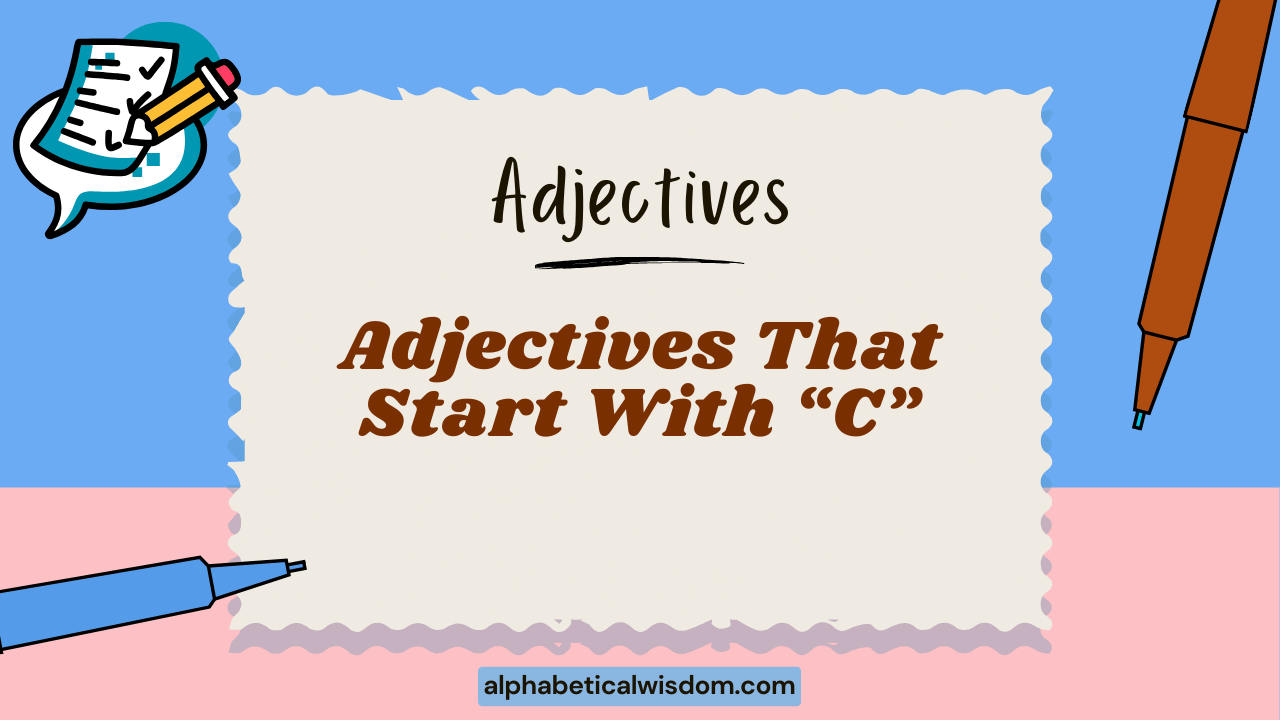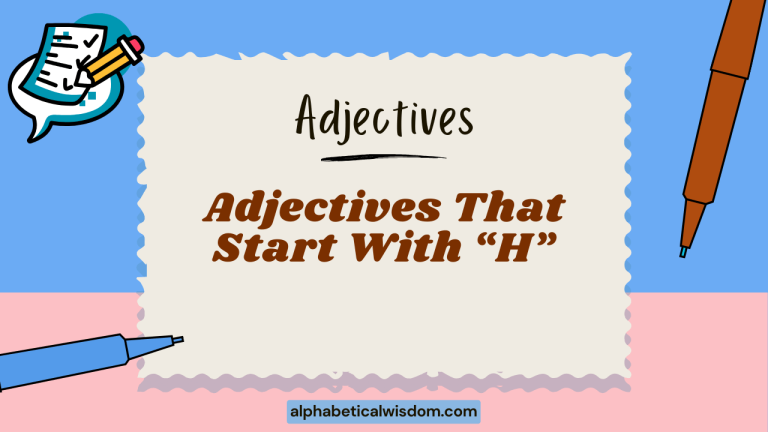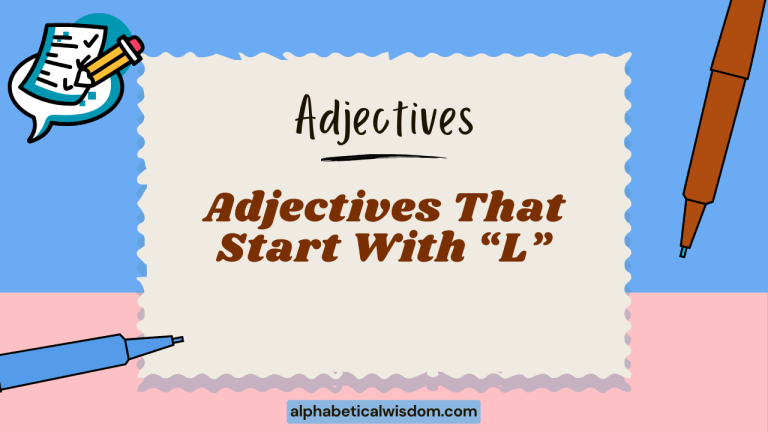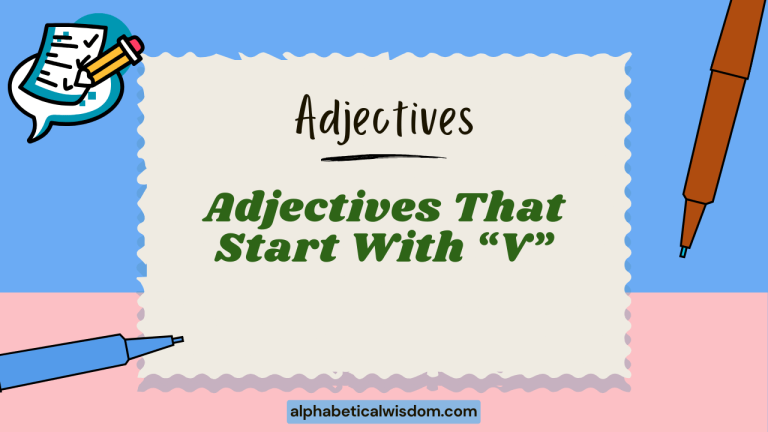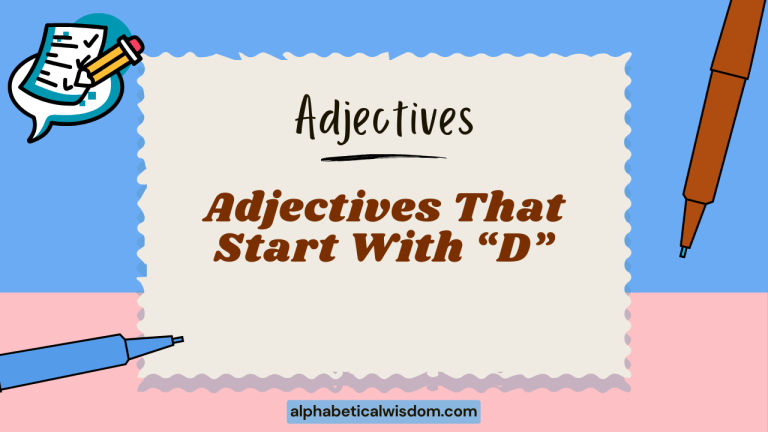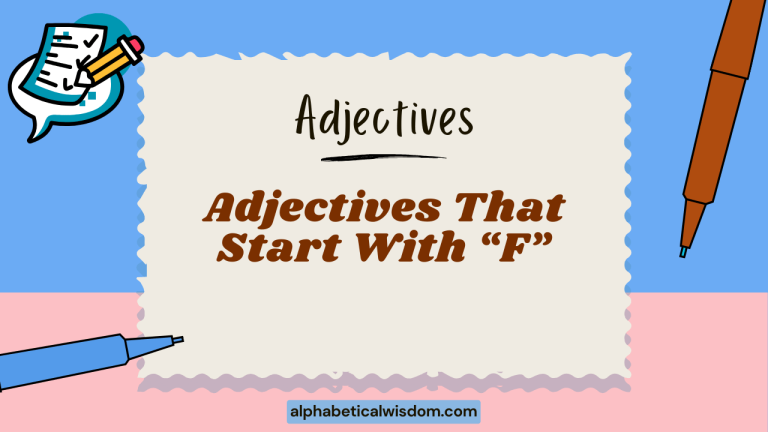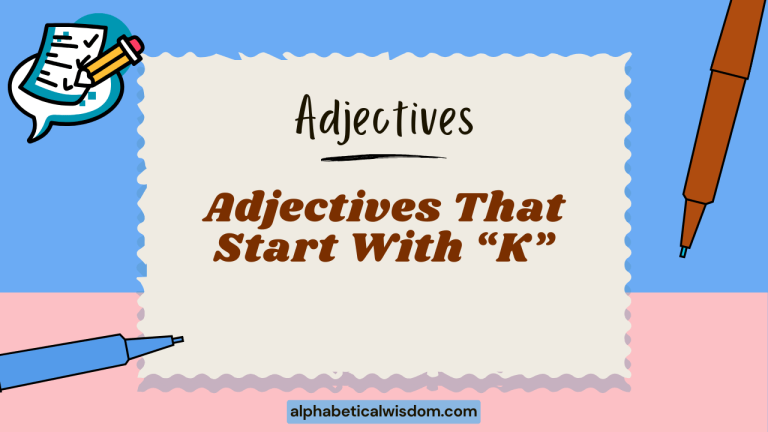Adjectives That Start With C: Comprehensive Grammar Guide
Adjectives are the descriptive powerhouses of the English language, adding color and detail to our sentences. Mastering adjectives, especially those starting with the letter ‘C,’ is crucial for enhancing your vocabulary and improving your writing and speaking skills.
This guide provides a detailed exploration of adjectives starting with ‘C,’ covering their definitions, usage, and common pitfalls. Whether you’re a student, a language enthusiast, or simply looking to refine your English, this article will equip you with the knowledge to use these adjectives effectively and confidently.
This guide aims to boost your understanding of English grammar and enhance your descriptive capabilities. By exploring various categories, examples, and practical exercises, you’ll gain a deeper appreciation for the nuances of adjectives starting with ‘C.’ Prepare to expand your linguistic toolkit and express yourself with greater precision and flair.
Table of Contents
- Introduction
- Definition of Adjectives
- Structural Breakdown
- Types of Adjectives
- Examples of Adjectives Starting With C
- Usage Rules for Adjectives Starting With C
- Common Mistakes
- Practice Exercises
- Advanced Topics
- FAQ
- Conclusion
Definition of Adjectives
An adjective is a word that modifies a noun or pronoun, providing more information about its qualities, characteristics, or state. Adjectives add detail and specificity to our language, making descriptions more vivid and engaging.
They answer questions like “What kind?”, “Which one?”, “How many?”, or “How much?” about the noun or pronoun they modify.
Adjectives can be classified into various types based on their function and form. These include descriptive adjectives, quantitative adjectives, demonstrative adjectives, possessive adjectives, interrogative adjectives, and articles.
Understanding these classifications helps in using adjectives correctly and effectively.
Classification of Adjectives
- Descriptive Adjectives: Describe the qualities or characteristics of a noun (e.g., careful driver, charming smile).
- Quantitative Adjectives: Indicate the quantity or amount of a noun (e.g., certain amount, considerable number).
- Demonstrative Adjectives: Point out specific nouns (e.g., this car, that house).
- Possessive Adjectives: Show ownership (e.g., my book, her car).
- Interrogative Adjectives: Used in questions to ask about nouns (e.g., which way, whose pen).
- Articles: A, an, and the, which specify or generalize nouns.
Function of Adjectives
The primary function of an adjective is to modify a noun or pronoun, providing additional information and detail. Adjectives can appear before the noun they modify (attributive position) or after a linking verb (predicative position).
Their placement and usage significantly impact the clarity and effectiveness of sentences.
Contexts of Adjective Use
Adjectives are used in various contexts, including descriptive writing, narrative storytelling, persuasive arguments, and technical reports. The choice of adjectives can significantly influence the tone, style, and impact of the writing.
In formal writing, precise and objective adjectives are preferred, while creative writing often employs more evocative and imaginative adjectives.
Structural Breakdown
Adjectives can be simple, compound, or participial in structure. Simple adjectives consist of a single word, while compound adjectives are formed by combining two or more words, often hyphenated.
Participial adjectives are derived from verbs and function as adjectives.
The position of an adjective in a sentence can affect its meaning and emphasis. Attributive adjectives typically precede the noun, while predicative adjectives follow a linking verb.
Understanding these structural elements is essential for constructing grammatically correct and stylistically effective sentences.
Simple Adjectives
Simple adjectives are single-word adjectives that directly modify a noun or pronoun. Examples include clean, clear, and cold. These adjectives are fundamental to descriptive language and are widely used in everyday communication.
Compound Adjectives
Compound adjectives are formed by combining two or more words, often hyphenated, to create a single descriptive unit. Examples include color-coded, cross-functional, and cost-effective. These adjectives provide more nuanced and specific descriptions.
Participial Adjectives
Participial adjectives are derived from verbs and function as adjectives. They can be present participles (ending in -ing) or past participles (usually ending in -ed or -en). Examples include challenging task and cracked vase.
Types of Adjectives
Adjectives can be categorized based on their function and the type of information they provide. Understanding these categories helps in selecting the most appropriate adjective for a given context, enhancing the precision and clarity of your writing.
Descriptive Adjectives Starting With ‘C’
Descriptive adjectives are the most common type, providing details about the qualities or characteristics of nouns. Examples include charming, courageous, and creative. These adjectives enrich descriptions and make writing more engaging.
Quantitative Adjectives Starting With ‘C’
Quantitative adjectives indicate the quantity or amount of a noun. Examples include certain, considerable, and countless. These adjectives provide information about the number or extent of something.
Other Adjective Types
- Proper Adjectives: Derived from proper nouns (e.g., Canadian flag, Chinese food).
- Demonstrative Adjectives: Indicate specific nouns (e.g., this car, that house). While ‘C’ doesn’t commonly start demonstrative adjectives, understanding their function is important.
Examples of Adjectives Starting With C
This section provides extensive examples of adjectives starting with ‘C,’ categorized by their type and usage. These examples illustrate how adjectives can enhance descriptions and add detail to sentences.
By studying these examples, you can improve your vocabulary and understanding of adjective usage.
Descriptive Adjectives Examples
Descriptive adjectives starting with ‘C’ enrich our descriptions and make our language more vibrant. The following table presents a variety of descriptive adjectives and their usage in sentences.
| Adjective | Example Sentence |
|---|---|
| Calm | The calm sea reflected the clear sky. |
| Capable | She is a capable leader who inspires her team. |
| Careful | A careful driver always checks their mirrors. |
| Charming | The charming village attracted many tourists. |
| Cheerful | Her cheerful disposition brightened the room. |
| Chief | The chief reason for the delay was the bad weather. |
| Chilly | A chilly breeze swept through the mountains. |
| Chronic | He suffered from a chronic back pain. |
| Classic | The classic car was a true beauty. |
| Clean | A clean environment is essential for good health. |
| Clear | The clear instructions made the task easy. |
| Clever | He is a clever student with a bright future. |
| Cloudy | The sky was cloudy, threatening rain. |
| Clumsy | He is a clumsy dancer, but he enjoys it. |
| Coarse | The coarse fabric felt rough against the skin. |
| Cold | A cold wind blew through the city. |
| Colorful | The garden was filled with colorful flowers. |
| Comfortable | The comfortable chair was perfect for reading. |
| Common | It is common knowledge that exercise is good for you. |
| Complete | A complete set of tools is necessary for the job. |
| Complex | The complex problem required careful analysis. |
| Complicated | The complicated system was difficult to understand. |
| Comprehensive | The comprehensive report covered all aspects of the project. |
| Compulsory | Attendance is compulsory for all students. |
| Concerned | The concerned parents worried about their child. |
| Concrete | We need concrete evidence to support the claim. |
| Confident | She is a confident speaker who captivates her audience. |
| Constant | The constant noise was driving him crazy. |
| Content | He seemed content with his simple life. |
Quantitative Adjectives Examples
Quantitative adjectives starting with ‘C’ specify the amount or quantity of a noun. The table below illustrates their usage with example sentences.
| Adjective | Example Sentence |
|---|---|
| Certain | A certain number of students failed the exam. |
| Considerable | There was a considerable amount of damage after the storm. |
| Countless | He has faced countless challenges in his career. |
| Copious | The library has a copious collection of books. |
| Critical | A critical mass of support is needed for the project to succeed. |
| Cumulative | The cumulative effect of small changes can be significant. |
| Current | The current population of the city is growing rapidly. |
| Close | A close inspection of the data revealed some discrepancies. |
| Chief | The chief difficulty lies in securing funding. |
| Concluding | The Concluding remarks summarized the main points of the presentation. |
| Competitive | A competitive market drives innovation and efficiency. |
| Component | Each component part is carefully inspected before assembly. |
| Conditional | The approval is conditional on meeting certain requirements. |
| Conjugal | Conjugal visits are allowed for inmates in good standing. |
| Consecutive | The team won five consecutive games. |
| Consequent | The consequent increase in demand led to higher prices. |
| Constructive | We need constructive feedback to improve our performance. |
| Contingent | Our plans are contingent upon the weather. |
| Continuing | The continuing education program helps professionals stay updated. |
| Contractual | We have a contractual obligation to fulfill the agreement. |
| Contrary | Contrary to popular belief, the Earth is not flat. |
| Contributing | Every contributing factor was carefully considered in the analysis. |
| Controlling | The controlling interest in the company is held by the founder. |
| Convenient | The Convenient location of the store attracts many customers. |
| Conventional | Conventional wisdom suggests that hard work leads to success. |
| Corporate | The corporate headquarters are located in New York City. |
| Corresponding | There is a corresponding increase in revenue with the new product launch. |
| Cosmic | The cosmic microwave background radiation is evidence of the Big Bang. |
| Costly | The costly repairs were necessary to keep the machine running. |
Proper Adjectives Examples
Proper adjectives are derived from proper nouns and modify other nouns. Examples below show how proper adjectives starting with ‘C’ are used.
| Adjective | Example Sentence |
|---|---|
| Canadian | The Canadian Rockies are a popular tourist destination. |
| Chinese | Chinese cuisine is known for its diverse flavors. |
| Christian | The Christian church played a significant role in the community. |
| Californian | The Californian sunshine is perfect for outdoor activities. |
| Colombian | Colombian coffee is renowned for its rich aroma. |
| Cuban | The Cuban cigar is internationally recognized. |
| Czech | The Czech Republic is known for its beer. |
| Chilean | Chilean wines are exported worldwide. |
Usage Rules for Adjectives Starting With C
Adjectives must agree in number and gender with the nouns they modify in some languages, but English does not have grammatical gender or noun agreement. However, there are still rules to follow to use adjectives correctly.
Attributive vs. Predicative Usage
Adjectives can be used attributively (before the noun) or predicatively (after a linking verb). The choice between these positions can affect the emphasis and flow of the sentence.
For example:
- Attributive: The charming house stood on the hill.
- Predicative: The house is charming.
Order of Adjectives
When using multiple adjectives to describe a noun, there is a general order to follow: opinion, size, age, shape, color, origin, material, and purpose. For example: “a beautiful large old round red Italian wooden dining table.”
Comparative and Superlative Forms
Many adjectives can form comparative and superlative degrees to show comparison. For shorter adjectives, add “-er” and “-est” (e.g., clearer, clearest). For longer adjectives, use “more” and “most” (e.g., more complex, most complex).
Common Mistakes
Even experienced English speakers sometimes make mistakes with adjectives. Understanding these common errors can help you avoid them and improve your writing and speaking.
Incorrect Use of Comparative and Superlative Forms
Using “more” or “most” with adjectives that already have “-er” or “-est” endings is a common mistake. For example:
- Incorrect: more clearer
- Correct: clearer
- Incorrect: most clearest
- Correct: clearest
Misplaced Adjectives
Placing an adjective in the wrong position can change the meaning of a sentence. Be sure to place adjectives close to the nouns they modify.
- Incorrect: He saw a cat running quickly. (Did the cat run quickly or was the seeing quick?)
- Correct: He quickly saw a running cat. (The seeing was quick)
- Correct: He saw a quickly running cat. (The cat was running quickly)
Confusion of Adjectives and Adverbs
Adjectives modify nouns, while adverbs modify verbs, adjectives, or other adverbs. Using an adjective instead of an adverb (or vice versa) is a common mistake.
For example:
- Incorrect: He performed good on the test.
- Correct: He performed well on the test.
- Incorrect: She is a real quick runner.
- Correct: She is a really quick runner.
Practice Exercises
Test your knowledge of adjectives starting with ‘C’ with these practice exercises. Each exercise focuses on a different aspect of adjective usage.
Exercise 1: Fill in the Blanks
Fill in the blanks with an appropriate adjective starting with ‘C’.
| Question | Answer |
|---|---|
| 1. The _______ sea was perfect for sailing. | Calm |
| 2. She is a _______ leader who inspires confidence. | Capable |
| 3. A _______ driver always obeys traffic laws. | Careful |
| 4. The _______ village attracted many tourists. | Charming |
| 5. Her _______ smile brightened the room. | Cheerful |
| 6. The _______ reason for the delay was the weather. | Chief |
| 7. A _______ breeze swept through the mountains. | Chilly |
| 8. He suffered from _______ back pain. | Chronic |
| 9. The _______ car was a true beauty. | Classic |
| 10. A _______ environment is essential for health. | Clean |
Exercise 2: Identify the Adjectives
Identify the adjectives starting with ‘C’ in the following sentences.
| Question | Answer |
|---|---|
| 1. The clear instructions made the task easy. | Clear |
| 2. He is a clever student with a bright future. | Clever |
| 3. The cloudy sky threatened rain. | Cloudy |
| 4. He is a clumsy dancer but enjoys it. | Clumsy |
| 5. The coarse fabric felt rough. | Coarse |
| 6. A cold wind blew. | Cold |
| 7. The colorful garden was beautiful. | Colorful |
| 8. The comfortable chair was perfect. | Comfortable |
| 9. It is common knowledge. | Common |
| 10. A complete set is needed. | Complete |
Exercise 3: Correct the Mistakes
Correct the mistakes in the following sentences involving adjectives starting with ‘C’.
| Question | Answer |
|---|---|
| 1. She is more cleverer than him. | She is cleverer than him. |
| 2. He has certainest information. | He has the most certain information. |
| 3. A considerable bigger problem arose. | A considerably bigger problem arose. |
| 4. The most chronic problem is funding. | The most chronic problem is funding. (Correct as is) |
| 5. He is more clumsier than her. | He is clumsier than her. |
| 6. This solution is more completer. | This solution is more complete. |
| 7. She is the most capableest person. | She is the most capable person. |
| 8. A cleanlier environment is healthier. | A cleaner environment is healthier. |
| 9. The cheerfulest girl won. | The cheerfullest girl won. |
| 10. The chiefest reason was lack of funds. | The chief reason was lack of funds. |
Advanced Topics
For advanced learners, this section delves into more complex aspects of adjective usage, including figurative language and idiomatic expressions.
Adjectives in Figurative Language
Adjectives play a crucial role in figurative language, such as metaphors and similes, adding depth and nuance to descriptions. Understanding how adjectives contribute to these figures of speech can enhance your writing and interpretive skills.
Idiomatic Expressions with Adjectives
Many idiomatic expressions incorporate adjectives, often with meanings that differ from the literal definitions of the words. Familiarizing yourself with these expressions can improve your fluency and comprehension.
FAQ
This section addresses frequently asked questions about adjectives, providing clear and concise answers to common queries.
- What is the difference between an adjective and an adverb?
Adjectives modify nouns or pronouns, while adverbs modify verbs, adjectives, or other adverbs. Adjectives describe what something *is*, while adverbs describe how something *does*.
- Can a noun be used as an adjective?
Yes, a noun can function as an adjective when it modifies another noun. This is known as a noun adjunct or attributive noun (e.g., “computer science,” “coffee cup”).
- How do I determine the correct order of adjectives in a sentence?
Follow the general order of adjectives: opinion, size, age, shape, color, origin, material, and purpose. This order helps ensure clarity and natural flow.
- What are comparative and superlative adjectives?
Comparative adjectives compare two things (e.g., “clearer”), while superlative adjectives compare three or more things (e.g., “clearest”). They are used to show degrees of comparison.
- How do I form comparative and superlative adjectives?
For shorter adjectives, add “-er” and “-est.” For longer adjectives, use “more” and “most.” Be aware of irregular forms (e.g., “good,” “better,” “best”).
- What is a compound adjective?
A compound adjective is formed by combining two or more words, often hyphenated, to create a single descriptive unit (e.g., “cost-effective,” “color-coded”).
- Can I use multiple adjectives to describe a noun?
Yes, you can use multiple adjectives, but be mindful of the order and avoid redundancy. Choose adjectives that add unique and valuable information.
- What are some common mistakes to avoid when using adjectives?
Avoid using “more” or “most” with adjectives that already have “-er” or “-est” endings, misplacing adjectives, and confusing adjectives with adverbs.
- What are participial adjectives?
Participial adjectives are derived from verbs and function as adjectives. They can be present participles (ending in -ing) or past participles (usually ending in -ed or -en).
- How do proper adjectives work?
Proper adjectives come from proper nouns and describe something associated with that noun. They are always capitalized (e.g., “Canadian,” “Chinese”).
Conclusion
Mastering adjectives that start with ‘C’ is a significant step towards enhancing your English language skills. By understanding their definitions, structural elements, and usage rules, you can express yourself with greater precision and flair.
Remember to practice regularly and pay attention to common mistakes to refine your adjective usage.
Continue to explore the nuances of English grammar and vocabulary to further improve your communication skills. With consistent effort and attention to detail, you can confidently use adjectives to enrich your writing and speaking, making your language more vivid and engaging.
Now you have the tools to confidently use adjectives starting with ‘C’ in your everyday communication.
